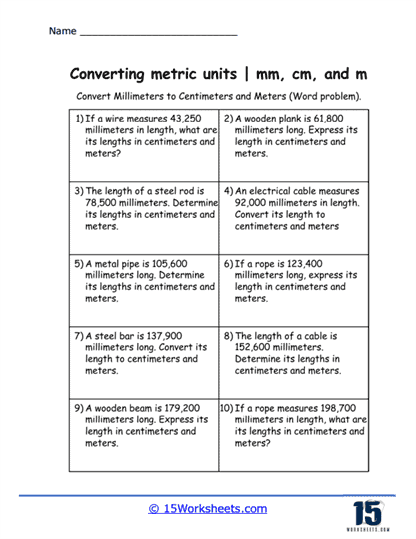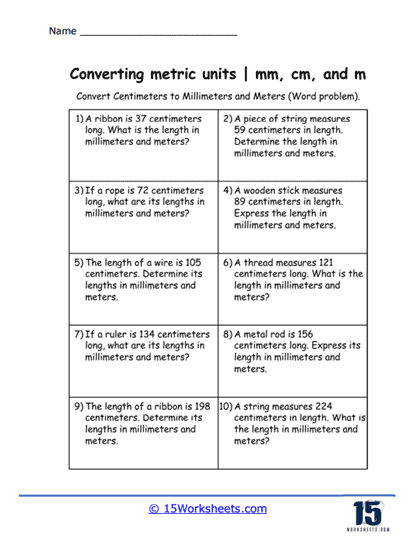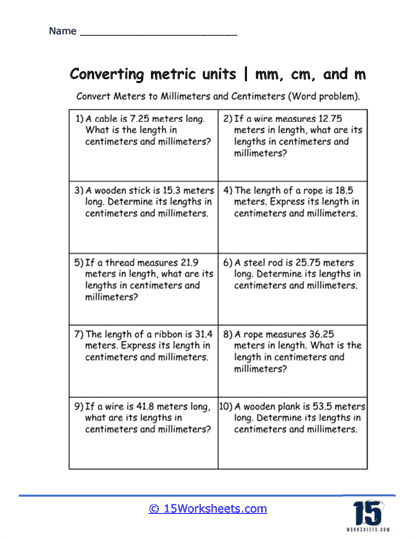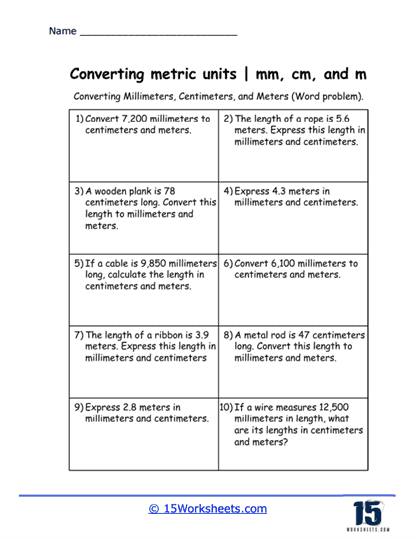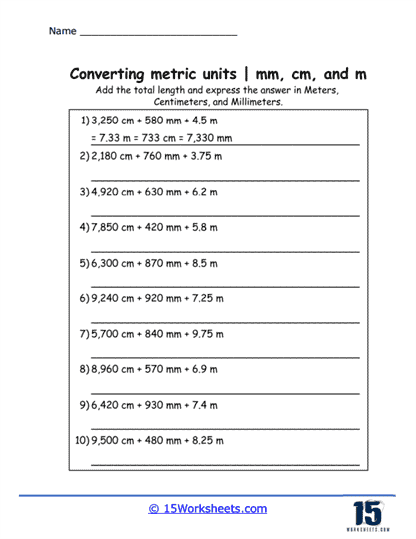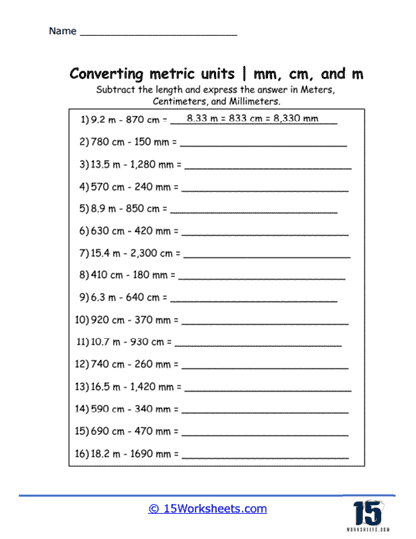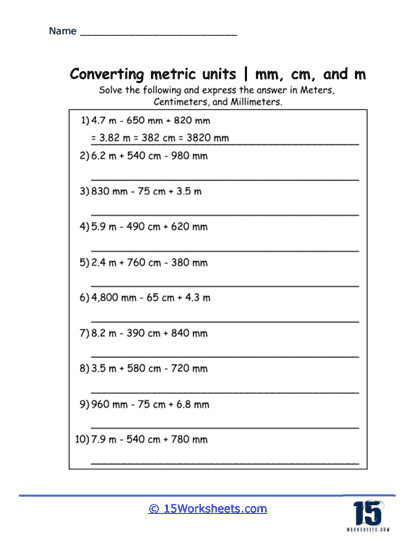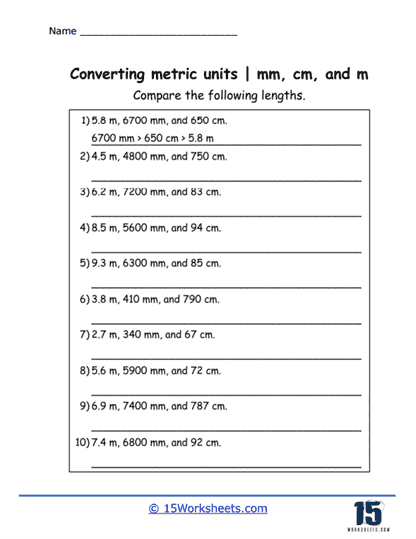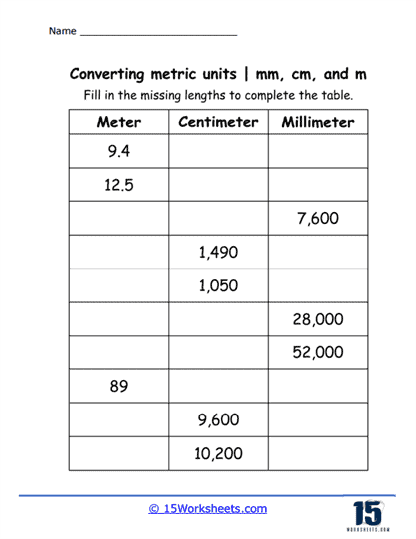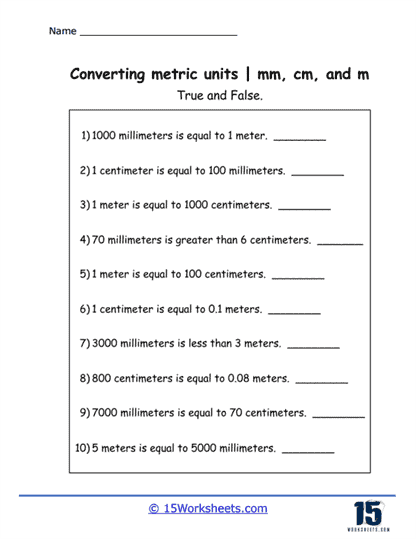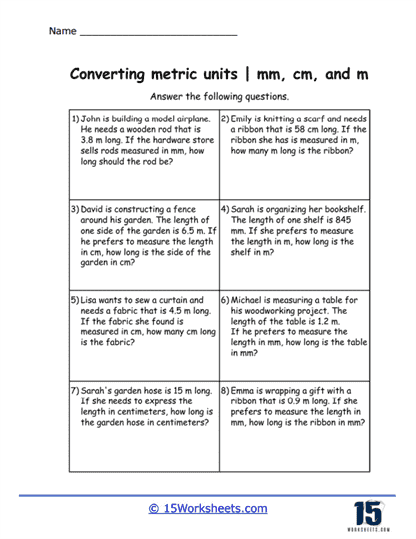Converting Metric Unit of Length Worksheets
About These 15 Worksheets
These worksheets help students grasp the concept of measuring length, understand the different units used, and apply these measurements in various contexts. These worksheets are commonly used in elementary and middle school to reinforce and expand students’ understanding of measurement in both the Imperial and metric systems. The exercises included in these worksheets are varied, catering to different learning styles and objectives, from simple identification of units to complex problem-solving scenarios involving conversions and real-world applications.
From simple matching exercises to complex real-world application problems, these worksheets provide comprehensive coverage of the concept of length. Through a variety of exercises, they help students not only understand different units of length and their conversions but also apply this knowledge in practical, meaningful ways. As students progress through different levels of education, these worksheets adapt to challenge their growing skills, ensuring that their understanding of measurement is both deep and applicable to real-world scenarios.
1. Basic Identification and Matching Exercises – These worksheets often begin with fundamental exercises that require students to identify various units of length. For younger students, this might involve matching familiar objects with the appropriate units of measurement, such as pencils with inches or a school bus with meters. These activities help students begin to associate everyday items with their approximate measurements, laying a foundation for more precise calculations later.
2. Conversion Exercises – Conversion exercises are a critical component of units of length worksheets. These exercises challenge students to convert units within the same measurement system (e.g., inches to feet, centimeters to meters) and across systems (e.g., inches to centimeters). Worksheets may present these conversions in various formats:
Direct Conversion Problems – Students are given specific measurements to convert from one unit to another using conversion factors.
Conversion Tables – Students fill in tables that help visualize and calculate multiple conversions between units.
Word Problems – These problems contextualize conversions in real-life scenarios, such as determining the height of a plant in different units or converting the length of a room for a renovation project.
3. Estimation and Comparison – Worksheets may also include exercises that focus on estimating and comparing lengths. Estimation tasks might ask students to guess the length of an object before measuring it, helping them develop a sense of scale and measurement intuition. Comparison problems could involve ranking several items by size or determining the difference in length between two objects. These exercises emphasize critical thinking and practical application of measurement concepts.
4. Scale and Proportion Exercises – As students advance, worksheets incorporate more complex problems involving scales and proportions. For instance, exercises might require students to interpret a scale drawing or map. Here, understanding the relationship between a unit of length on the paper and its real-world equivalent is crucial. Students might be asked to calculate actual distances based on a given scale, which combines their knowledge of units of length with multiplication and division skills.
5. Measurement Using Tools – Practical exercises that involve using tools like rulers, tape measures, or meter sticks are also common in these worksheets. These tasks require students to measure actual objects around their home or school environment. This hands-on approach not only helps students practice using measurement tools effectively but also reinforces the practical relevance of understanding and applying different units of length.
6. Geometry Integration – Units of length worksheets often intersect with geometric concepts. Exercises might include calculating the perimeter or area of various shapes, requiring students to measure or convert units of length to complete their calculations. These problems enhance spatial reasoning and illustrate how units of length apply in different mathematical contexts.
Some worksheets integrate length measurements with skills like graphing or interpreting data. Students might graph the heights of classmates in different units or analyze a chart that shows the growth of a plant over several weeks. These exercises help students see how units of length are used in data collection and presentation, enhancing their analytical skills.
Units of Length
Length, in the context of measurement, refers to the measurement of the distance between two points. It is one of the most commonly used measurements in the physical sciences, engineering, construction, and daily life, helping to define the dimensions of objects and spaces. Length can be measured in various units, which differ based on the measurement system used. The most widely used systems for measuring length are the metric system and the Imperial (or U.S. customary) system, each comprising different units that are used in specific contexts depending on regional and industrial preferences.
Metric System
The metric system is a decimal-based system of measurement that is used globally, particularly in science, industry, and most countries outside the United States. Here are the primary units of length in the metric system:
Millimeter (mm) – The smallest common metric unit of length, often used to measure small objects such as screws or the thickness of card stock.
Centimeter (cm) – Commonly used in everyday measurements, such as dimensions of furniture or personal heights, particularly in countries that use the metric system.
Meter (m) – The fundamental unit of length in the metric system, used to measure room sizes, the height of buildings, or the length of sports fields.
Kilometer (km) – Used for longer distances such as the length of roads or between geographic locations.
Imperial System
The Imperial system, which is primarily used in the United States, includes units such as inches, feet, yards, and miles:
Inch (in) – Used frequently in the U.S. for measuring small lengths, such as the dimensions of a phone screen or the diameter of a pipe.
Foot (ft) – Commonly used to express human height, room dimensions, and shorter distances in fields like real estate and construction.
Yard (yd) – Used in a variety of applications, including fabric measurements and lengths in sports like football.
Mile (mi) – The standard unit for measuring longer distances, such as the distance between cities or lengths of races in track and field.
Additional Systems and Units
Besides these common units, there are specialized units used in specific contexts or regions:
Nautical mile – Used in aviation and maritime navigation, a nautical mile is based on the circumference of the Earth and is important for gauging travel distances at sea.
Astronomical unit (AU) – Used in astronomy, one AU is approximately equal to the distance from the Earth to the Sun, helping astronomers compute distances within our solar system.
Light-year – Also used in astronomy, a light-year measures the distance light travels in one year, which is crucial for measuring vast distances across the universe.
Real-World Applications
Units of length are essential across various fields and activities:
Construction and Engineering – Accurate measurements of length are critical for planning and executing construction projects, ensuring that structures are built correctly and safely.
Manufacturing – In manufacturing, units of length determine the dimensions of products, from tiny electronic components to large vehicles, ensuring consistency and functionality.
Retail – In retail, measurements are used to specify product dimensions, affecting everything from packaging to display arrangements.
Sports – Many sports rely on precise measurements to standardize playing fields and equipment, such as the length of a basketball court or the height of a volleyball net.
Transportation – Transportation systems, from local to global scales, depend on measurements of length, such as designing roads, planning air routes, or navigating the seas.
Understanding and using the correct units of length allows for precise communication and execution of plans in scientific, industrial, and everyday contexts, making it one of the most fundamental aspects of measurement.




